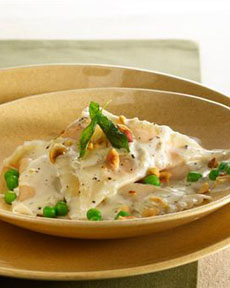TIP OF THE DAY: Make Dumplings Or Ravioli From Thanksgiving Leftovers
|
If you still have Thanksgiving leftovers, this tip from Chef Johnny Gnall shows how to turn them into favorite comfort foods: dumplings or ravioli. If you have questions or suggestions for tips, email Chef Johnny. At Thanksgiving, just about every content source offers you a new take on what to do with leftovers. Here’s my take: Use them to stuff dumplings! It gives you the chance to practice your dumpling- or ravioli-making skills and produces some delicious pasta. Dumplings are a stuffed pasta similar to ravioli or tortellini, but with a thicker dough. If you have a pasta machine to press out thin dough, go for the ravioli! All the Ziploc bags and Tupperware in my fridge, crammed full of leftover Thanksgiving goodness, were soon transformed into dumpling goodness (and you can freeze any extra dumplings). So impress your family and friends with fresh, handmade pasta that lights up their taste buds and reminds them of that most special of eating holidays: Thanksgiving! I guarantee you they will GOBBLE it up, and may well demand that it become an annual event. |
|
|
|
HOW TO MAKE “THANKSGIVING DUMPLINGS” OR RAVIOLI First, make a simple pasta dough by mixing 1 egg, 1 cup of sifted flour and 2 or 3 tablespoons of room temperature water. Professionals will do this on any clean, floured surface; but use a large bowl if you want to keep things contained and neat. |
||
 Ravioli stuffed with leftover turkey and butternut squash. We even used up the last of the peas and the sage. Photo courtesy McCormick.com. |
|
|
|
RAVIOLI FILLING IDEAS Here are five delicious fillings I made for my own pastas, all from fully cooked leftovers straight out of the fridge: Use these ideas as a jumping-off point, but remember that the point is to eat up the leftovers in a fun and delicious way, whether they’re from Thanksgiving, Christmas, Chanukah or last Thursday. Review my tip on “Guerilla Cooking”, then head to your fridge, grab all leftovers you can carry and begin to perfect your handmade pasta technique!
|
||



